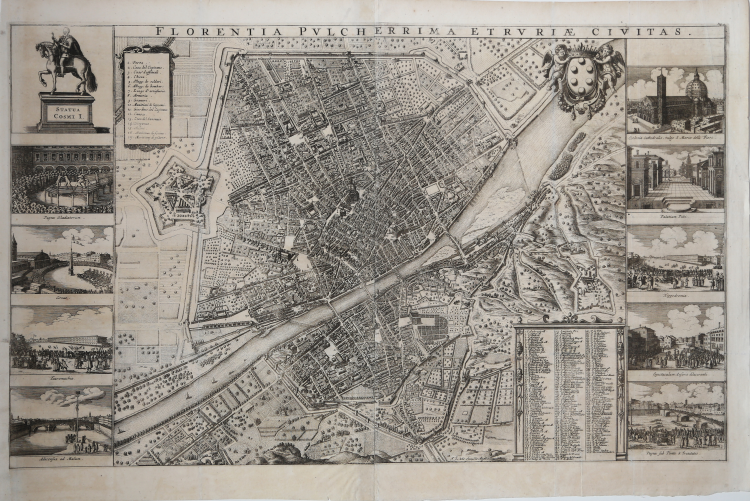



| Reference: | s34904 |
| Author | Frederick de WIT |
| Year: | 1660 ca. |
| Zone: | Florence |
| Printed: | Venice |
| Measures: | 730 x 450 mm |


| Reference: | s34904 |
| Author | Frederick de WIT |
| Year: | 1660 ca. |
| Zone: | Florence |
| Printed: | Venice |
| Measures: | 730 x 450 mm |
Perspective map of Florence, with the river Arno running lower left. to upper right., where two cherubs hold the city arms; with ten small views on either side of Florentine scenes, a key numbered 1-228 in the lower right. corner and a small key of the citadel in the upper left corner; after Stefano Bonsignori (1584)
Views at left and right margins: Statua Cosmi I -- Pugna Gladiatorum -- Circus -- Tauromachia -- Adscensus ad Malum -- Ecclesia Cathedralis, vulgo S. Marie delli Fiori -- Palatium Pitti -- Hippodromia -- Spectaculum Anseris Dilacerandi -- Pugna su Ponte S. Trinitatis.
The map was engraved around 1660 by Wenzel Hollar.
The map was re-issued by F. de Wit in Amsterdam in 1700.
Copper engraving, printed on two sheets joined, in very good condition.
|
Boffito, Mori, 1973, p.75.
|
Frederick de WIT (1630 - 1706)
|
De Wit was one of the most prominent and successful map engravers and publishers in Amsterdam in the period following the decline of the Blaeu and Jansson establishments, from which he acquired many copper plates when they were dispersed at auction. His output covered most aspects of map making: sea charts, world atlases, an atlas of the Netherlands, 'town books' covering plans of towns and cities in the Netherlands and Europe, and wall maps. His work, notable for the beauty of the engraving and colouring, was very popular and editions were issued many years after his death by Pieter Mortier and Covens and Mortier.
|
|
Boffito, Mori, 1973, p.75.
|
Frederick de WIT (1630 - 1706)
|
De Wit was one of the most prominent and successful map engravers and publishers in Amsterdam in the period following the decline of the Blaeu and Jansson establishments, from which he acquired many copper plates when they were dispersed at auction. His output covered most aspects of map making: sea charts, world atlases, an atlas of the Netherlands, 'town books' covering plans of towns and cities in the Netherlands and Europe, and wall maps. His work, notable for the beauty of the engraving and colouring, was very popular and editions were issued many years after his death by Pieter Mortier and Covens and Mortier.
|